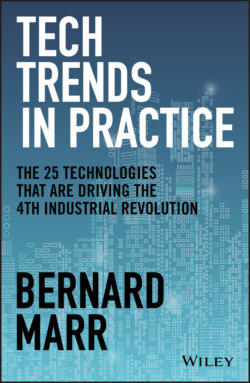Читать книгу Tech Trends in Practice - Бернард Марр, Bernard Marr - Страница 10
What Is Artificial Intelligence and Machine Learning?
ОглавлениеSpeaking in 2016, Stephen Hawking said, “Success in creating AI would be the biggest event in human history.” Now, it’s no secret that technology trends often create a lot of hype. But in the case of AI, the hype is warranted. Like Hawking, I believe AI will transform our world and how we live in it.
AI and machine learning already plays a bigger role in everyday life than you might imagine. Alexa, Siri, Amazon’s product recommendations, Netflix’s and Spotify’s personalized recommendations, every Google search you make, security checks for fraudulent credit card purchases, dating apps, fitness trackers … all are driven by AI.
AI and machine learning is the foundation on which many other technology trends in this book are built. For instance, without AI, we wouldn’t have achieved the amazing advances in the Internet of Things (IoT, Trend 2), virtual reality (Trend 8), chatbots (Trend 11), facial recognition (Trend 12), robotics and automation (Trend 13), or self-driving cars (Trend 14) – to name just a few.
But what exactly is AI and machine learning, and how does it work? In very simple terms, AI involves applying an algorithm (a rule or calculation) to data in order to solve problems, identify patterns, decide what to do next, and maybe even predict future outcomes. Crucial to this process is an ability to learn from data and get better at interpreting data over time. And this is where the machine learning part comes in. Machine learning is a subdiscipline of AI, and it involves creating machines that can learn. (“Machines,” by the way, may include computers, smart phones, software, industrial equipment, robots, vehicles, etc.)
The human brain learns from data, not a preprogrammed set of rules. We humans are continually interpreting and learning from the world around us. We generally get better at this process over time, learning from our successes and failures. And we make decisions or take action based on what we’ve learned. AI – or, more specifically, machine learning – replicates this process, but in machines. So, rather than just giving a machine a set of rules to follow, machines can now “learn” from data. Deep learning is another AI-related term that you might have heard. If machine learning is a subset of AI, deep learning is a subset of machine learning – it’s essentially a more cutting-edge form of machine learning, involving more complex layers of data processing. (For the purposes of this chapter, both machine learning and deep learning will be wrapped up in the umbrella term AI.)
Like humans, the more data a machine has to learn from, the smarter it becomes. That explains why AI has made such dramatic advances in the last few years – advances that we might not have thought possible 10 or even five years ago. Modern AI needs data to function. And we’re now creating more data than ever before (see Big Data, Trend 4). This continual expansion in data, along with advances in computing power, is fueling a rapid acceleration of AI capabilities.
AI isn’t just infiltrating our everyday lives; it’s going to transform our industries and businesses. According to one survey, 73% of senior executives see AI, machine learning, and automation as important areas to maintain or increase investment in.1 (Governments, too, are prioritizing AI investment. In 2019, the White House launched a National AI Initiative directing government agencies to commit to advancing AI.2)
As well as transforming entire businesses and industries, AI is also going to transform many human jobs. IBM predicts that more than 120 million workers globally will need to be retrained in the next three years due to AI.3 AI-enabled automation (see Trend 22) will have a particularly significant impact and may lead to the displacement of many jobs. But rather than subscribe to a vision of a dystopian future where all human jobs are given over to robots, I believe AI will make our working lives better. Yes, jobs will be impacted by automation and AI, and many current human jobs will no longer exist in 10 or 20 years’ time. But AI will enhance the work of humans, and new jobs will arise to replace displaced jobs. (Just think how computing and the internet led to the demise of some jobs but created many more new roles.) What’s more, as machines become more intelligent and capable of carrying out more human tasks, I believe that our uniquely human capabilities – things like creativity, empathy, and critical thinking – will become all the more precious and valuable in the workplaces of the future.
